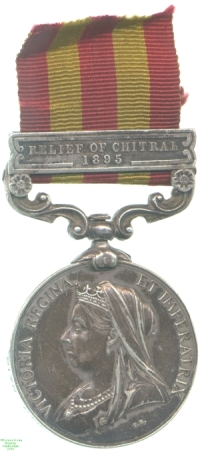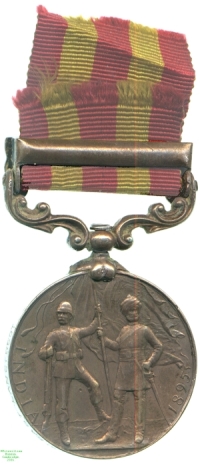
Obverse, a bust of Queen Victoria

Reverse, a British and an Indian soldier supporting a standard together

Obverse, a bust of Queen Victoria |

Reverse, a British and an Indian soldier supporting a standard together |
By 1895 it was beginning to be considered that the 23 bars issued to the India General Service Medal implied a need for its replacement, and in 1896 the new India Medal was first issued.
Chitral (now at the very northern edge of Pakistan) was a small border state between British India and Afghanistan, and thus the focus of considerable British attention. Considerably expanded under the Great Mehtar Aman ul-Mulk, the country was riven with a bloody succession crisis after his death in 1892, seeing five different rulers in the course of the next three years. Afghan interference in this conflict led the British to negotiate the emplacement of a garrison at Chitral in 1895 to safeguard their position. Amir al-Mulk, one of the rivals for the succession, thereupon seized Chitral and demanded recognition. When this could not be obtained Amir's support dwindled and a previously defeated rival, Shir Afzal Khan, returned from Afghanistan and besieged the British garrison in Chitral. They held out for a month until two separate relief expeditions could reach them, the second of which captured Shir Afzal, and deported both him and Amir al-Mulk to India, emplacing Shujah al-Mulk as Mehtar, who would rule until 1936.
This medal was awarded to Private S. Wilson, of the 1st East Lancashire Regiment, although this unit was not part of either of the Chitral relief expeditions. It has been renamed. Lester Watson acquired the medal at some point before 1928.